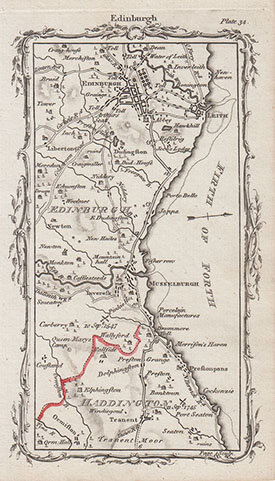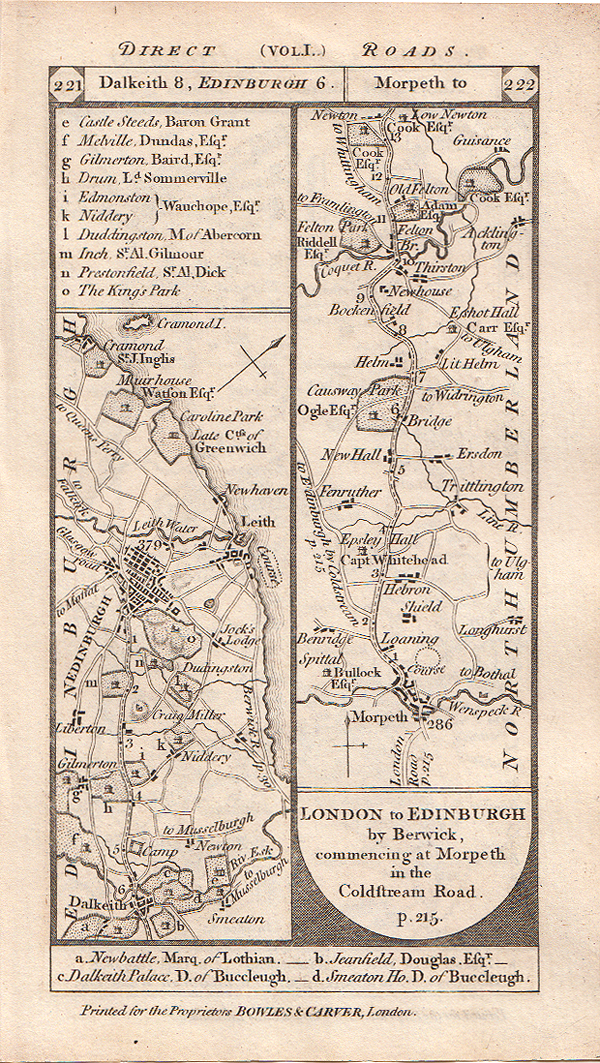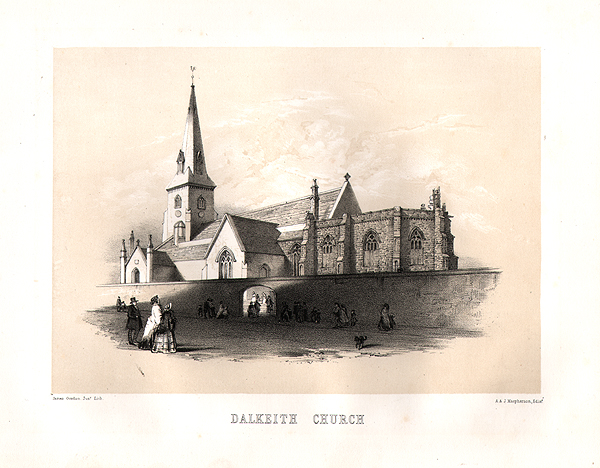Monday 25th October 1819
Monday Oct 25th At 12 o’clock we took our farewell of Edinburgh & proceeded to Dalkeith 7 miles, where we visited the Duke of Buccleuch’s a beautiful seat where there are
are some fine pictures thence to Fusay bridge 6 miles over a most dreary country changing horses to Torsants 14 miles here we slept the Inn is good.
OBSERVATIONS & COMMENTS:
Great North Road: They are now on the important Great North Road from Edinburgh to London: https://britishheritage.com/travel-through-time-at-englands-coaching-inns
M. J. Armstrong - Tranent, Musselburgh, Edinburgh. This is Plate 34 from "An Actual Survey of the Great Post-Roads between London and Edinburgh" by Mostyn John Armstrong, published in 1776. Each map shows a section of the road from London to Edinburgh drawn on the scale of half an inch to the mile. These maps are not strip road maps, but take the form of a conventional map covering an area of approximately 12 miles from south to north and 7 miles east to west. https://www.antique-prints-maps.com/cgi-bin/sh000001.pl?WD=north%20great%20road&PN=M_J_Armstrong%2ehtml#a781
Daniel Paterson - The Road from Dalkeith to Edinburgh and the road from Morpeth to Felton continuing on the verso to Alnwick, Belford and Berwick. Published in 'Paterson' s BRITISH ITINERARY being a new and accurate Delineation and Description of the Direct and Principal Cross Roads of Great Britain in two volumes by DANIEL PATERSON Esq.' Published by Bowles & Carver in 1800. https://antique-prints-maps.com/acatalog/ref1.php?imagefile=../largeimages/MapPR221.jpg
Dalkeith: One of the earliest historical references to Dalkeith is found in the Chronicles of Jean Froissart who stayed at Dalkeith Castle for fifteen days and writes of the Battle of Otterburn in 1388. In 1650, Oliver Cromwell's army came to Dalkeith. His officer General George Monck was Commander in Scotland, and the government of the country was based out of Dalkeith castle.
circa 1860: Dalkeith Church. Lithograph after James Gordon. Junr.. Published by A. & J. Macpherson, Edinburgh. https://antique-prints-maps.com/acatalog/ref1.php?imagefile=../largeimages/SEDalkeithChurch11.jpg
In the 17th century, Dalkeith had one of Scotland's largest markets in its exceptionally broad High Street. https://en.wikipedia.org/wiki/
2011: Now known as the St Nicholas Buccleuch Church, by Kim Traynor, the copyright holder of this work, published under the (CC SA-BY 3.0) Creative Commons Attribution-Share Alike 3.0 Unported license. https://commons.wikimedia.org/wiki/File:Dalkeith_Parish_Kirk.jpg
Dalkeith Palace was originally in the hands of the Clan Graham in the 12th century and given to the Clan Douglas in the early 14th century. In 1642, Dalkeith Castle was sold by the Douglas family to Francis Scott, 2nd Earl of Buccleuch, whose daughter married the Duke of Monmouth, eldest illegitimate son of King Charles II. They became the Duke and Duchess of Monmouth & Buccleuch. After the Duke of Monmouth had been executed for treason, Anne Scott, his widow, who held the Scottish title in her own right, asked architect James Smith to use William of Orange's Palace of Het Loo in the Netherlands as a model for the new Dalkeith Palace.
1788: Dalkeith Palace in Scotland, the Seat of the Duke of Duke of Buccleugh, from the Angus's Seats Series. Artist J Barret , Engraver William Angus, Publisher W. Angus, No. 4 Gwynne's Buildings, Islington http://www.rareoldprints.com/p/12160
Construction of Dalkeith Palace began in 1702 and a portion of the tower house of the old castle was incorporated into the western side of the new structure and is still visible in the western facade of the palace today. https://en.wikipedia.org/wiki/Dalkeith_Palace
1828: Dalkeith Palace. Engraving by T. Barber after J.P. Neale. https://antique-prints-maps.com/acatalog/ref1.php?imagefile=../largeimages/SEDalkeithPalace.jpg
1880: Dalkeith Palace in Scotland from Morris's Country Seats. This work is in the public domain. https://commons.wikimedia.org/wiki/File:DalkeithPalace_Morris_edited.jpg
Fusay bridge does not appear to exist, but Gorebridge lies 5.8 miles from Dalkeith on the A7 and is 15 miles to Torsonce, so is probably the village Lucy passed through. The village gets its name from the bridge across the River Gore, a tributary of the South Esk. It was the home of Scotland's first gunpowder mill, at the Gore Water, that started operating in 1794. https://en.wikipedia.org/wiki/Gorebridge * We have been contacted by Charles Gibb who has provided the following information: Fusay Bridge is now known as Fushiebridge and was about 1 km South East of Gorebridge on the A7 road. The original settlement no longer exists but it was at the junction of the A7 and the road to Catcune Mills, a corn mill powered by the Gore Water. Thank you Charles.
The Torsonce Coaching Inn: Old Manorhead is a large and distinctive building, prominently located beside the Galashiels Road. Built in 1819 as the Torsonce Coaching Inn, it was converted to a commodious house in 1852. Its large windows, restrained detailing and contrasting dark whinstone and light sandstone masonry all add to its interest. Of particular note are the very rare survival of fitted timber panel box-beds including a continuous run of three within the eaves of one attic room.The New Statistical Account of 1843 describes Torsonce Inn, located roughly half-way between Edinburgh and Selkirk, as being "much admired by travellers and perhaps unequalled by any country inn in Scotland". Today it is a listed building, Manorhead House, 168 Galashiels Road. https://britishlistedbuildings.co.uk/200353395-168-galashiels-road-manorhead-house-including-stables-cottage-boundary-walls-gatepiers-and-railings-galashiels-and-district-ward#.XDqVmVz7TIU
Can you help us?
Old Regency Prints, Pictures an Coaching maps: Do you have access to any prints or pictures showing what town and country would have looked like when Lucy travelled through? Any illustrations of what she would have seen in 1819 will enliven our research.
New Pictures: Do you have any modern pictures of the streets, buildings, gardens and views that would enable us to see the changes that two centuries have wrought?









